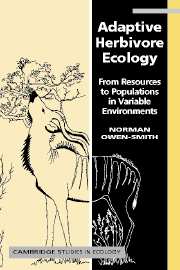Book contents
- Frontmatter
- Contents
- Acknowledgements
- Acronym and symbol conventions
- 1 Conceptual origins : variability in time and space
- 2 Consumer–resource models : theory and formulation
- 3 Resource abundance : intake response and time frames
- 4 Resource distribution : patch scales and depletion
- 5 Resource quality : nutritional gain and diet choice
- 6 Resource constraints : physiological capacities and costs
- 7 Resource allocation : growth, storage and reproduction
- 8 Resource production : regeneration and attrition
- 9 Resource competition : exploitation and density dependence
- 10 Resource-dependent mortality : nutrition, predation and demography
- 11 Habitat suitability : resource components and stocking densities
- 12 Resource partitioning : competition and coexistence
- 13 Population dynamics : resource basis for instability
- 14 An adaptive resource ecology : foundation and prospects
- References
- Index
8 - Resource production : regeneration and attrition
Published online by Cambridge University Press: 04 February 2011
- Frontmatter
- Contents
- Acknowledgements
- Acronym and symbol conventions
- 1 Conceptual origins : variability in time and space
- 2 Consumer–resource models : theory and formulation
- 3 Resource abundance : intake response and time frames
- 4 Resource distribution : patch scales and depletion
- 5 Resource quality : nutritional gain and diet choice
- 6 Resource constraints : physiological capacities and costs
- 7 Resource allocation : growth, storage and reproduction
- 8 Resource production : regeneration and attrition
- 9 Resource competition : exploitation and density dependence
- 10 Resource-dependent mortality : nutrition, predation and demography
- 11 Habitat suitability : resource components and stocking densities
- 12 Resource partitioning : competition and coexistence
- 13 Population dynamics : resource basis for instability
- 14 An adaptive resource ecology : foundation and prospects
- References
- Index
Summary
Vegetation constitutes a renewable resource that can be harvested through its consumption by herbivores. However, in seasonal environments the production of edible plant material does not take place continuously. Plants regenerate much of their above-ground biomass at the start of a growing season (early summer or rainy season), partly by reallocation from below-ground reserves. Later when conditions become adverse (too dry or too cold), they cease growth, and progressively shed the senescent parts. Superimposed on this seasonal cycle of growth and attrition are changes in plant populations, either through vegetative growth of new ramets, or via the recruitment of new individuals (genets) from seeds (Harper 1977).
Vegetation growth is not only phased seasonally, but also fluctuates in response to variability in weather during seasonal periods. Plants are a renewing resource for only a portion of the year, and a depleting resource for the remainder. Hence, no balanced equilibrium between production and consumption is maintained, except perhaps transiently. Because senescent parts are less nutritious than actively metabolizing leaves, herbivores must respond to seasonal changes in food quality as well as quantity. Different plant types and parts have distinctive patterns of growth and attrition in biomass and nutritional value.
In this chapter, an appropriate production function for the annual dynamics of the vegetation resource, accommodating this temporal and nutritional variability, is developed. The basis for this production, in terms of fluxes in sunlight, available moisture and mineral nutrients in soils, will not be considered explicitly.
- Type
- Chapter
- Information
- Adaptive Herbivore EcologyFrom Resources to Populations in Variable Environments, pp. 162 - 183Publisher: Cambridge University PressPrint publication year: 2002
- 1
- Cited by



